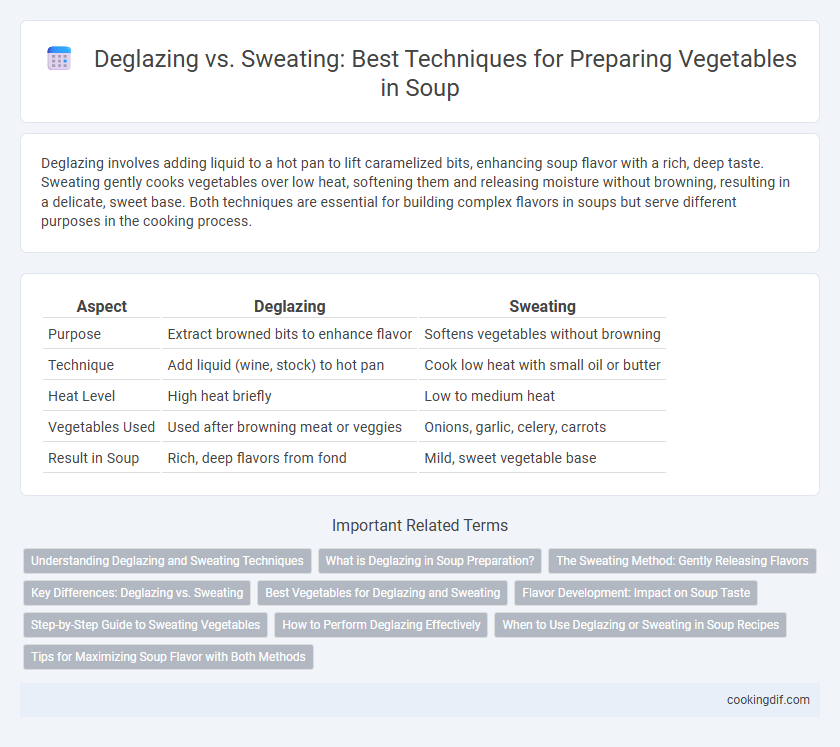Deglazing involves adding liquid to a hot pan to lift caramelized bits, enhancing soup flavor with a rich, deep taste. Sweating gently cooks vegetables over low heat, softening them and releasing moisture without browning, resulting in a delicate, sweet base. Both techniques are essential for building complex flavors in soups but serve different purposes in the cooking process.
Table of Comparison
| Aspect | Deglazing | Sweating |
|---|---|---|
| Purpose | Extract browned bits to enhance flavor | Softens vegetables without browning |
| Technique | Add liquid (wine, stock) to hot pan | Cook low heat with small oil or butter |
| Heat Level | High heat briefly | Low to medium heat |
| Vegetables Used | Used after browning meat or veggies | Onions, garlic, celery, carrots |
| Result in Soup | Rich, deep flavors from fond | Mild, sweet vegetable base |
Understanding Deglazing and Sweating Techniques
Sweating involves gently cooking vegetables over low heat with a small amount of oil or butter, softening them and releasing their natural moisture without browning, which enhances the base flavor of soups. Deglazing is the process of adding liquid, such as broth or wine, to a hot pan after sauteing vegetables or meat to dissolve the flavorful browned bits stuck to the pan, enriching the soup's depth and complexity. Mastering both techniques intensifies the soup's taste profile by layering subtle sweetness from sweating and robust umami from deglazing.
What is Deglazing in Soup Preparation?
Deglazing in soup preparation involves adding liquid such as broth, wine, or water to a hot pan after sauteing vegetables, which dissolves browned bits stuck to the bottom, enhancing the soup's depth of flavor and richness. This technique captures caramelized residues, creating a complex base for stocks or broths, essential in developing robust soup profiles. Deglazing differs from sweating, which gently cooks vegetables without browning, focusing on softening and releasing moisture to build a delicate flavor foundation.
The Sweating Method: Gently Releasing Flavors
Sweating vegetables involves cooking them slowly over low heat with minimal fat, allowing the natural flavors to gently release without browning. This method preserves the delicate sweetness and enhances the depth of flavor in soups by softening ingredients like onions, carrots, and celery. The moisture released during sweating helps create a flavorful base while maintaining the soup's clarity and color.
Key Differences: Deglazing vs. Sweating
Sweating vegetables involves cooking them over low heat with a small amount of fat to soften and release their moisture without browning, preserving delicate flavors ideal for soups. Deglazing is the process of adding liquid, such as broth or wine, to a hot pan after sauteing vegetables or meat, lifting caramelized bits to enrich the soup's taste. The key difference lies in sweating's role in gentle flavor development versus deglazing's function to capture and incorporate intense, cooked-on flavors.
Best Vegetables for Deglazing and Sweating
Root vegetables like carrots, onions, and celery are ideal for sweating, as their flavors gently soften without browning, releasing sweetness and depth essential for a rich soup base. Deglazing works best with vegetables that benefit from caramelization, such as mushrooms and bell peppers, where the fond enhances the soup's complexity by incorporating browned bits and intensified flavors. Balancing sweating and deglazing techniques optimizes the depth and aroma of vegetable soups, leveraging the unique qualities of each vegetable type.
Flavor Development: Impact on Soup Taste
Deglazing vegetables by adding liquid to a hot pan captures browned bits that intensify soup flavor with rich, caramelized notes. Sweating softens vegetables gently, preserving their natural sweetness and subtle taste essential for delicate broth bases. Combining both techniques enhances overall depth and complexity in soup, balancing robust and nuanced flavors.
Step-by-Step Guide to Sweating Vegetables
Sweating vegetables involves cooking them gently in a small amount of fat over low heat to soften without browning, which preserves their natural sweetness and enhances soup flavor. Start by heating oil or butter in a pan, then add diced onions, carrots, and celery, stirring frequently to release moisture while preventing color change. Maintain low heat and cover the pan if needed, allowing the vegetables to become translucent and tender before adding liquids or other ingredients to the soup.
How to Perform Deglazing Effectively
To perform deglazing effectively when preparing soup, begin by sweating vegetables over medium heat to soften them without browning. Once softened, add a small amount of liquid such as broth or wine to the hot pot, scraping the bottom with a wooden spoon to release and dissolve caramelized bits, enriching the soup's flavor. Maintain medium-high heat briefly to reduce the liquid slightly, concentrating the savory depth imparted by the deglazed fond.
When to Use Deglazing or Sweating in Soup Recipes
Sweating vegetables in soup recipes is ideal for gently softening ingredients and releasing their natural flavors without browning, perfect for creating a delicate base. Deglazing is best used after sauteing or browning vegetables or meat, where the caramelized bits stuck to the pan add depth, and liquid is added to lift those flavors into the soup. Select sweating to maintain subtle vegetable notes and choose deglazing when aiming for a richer, more complex broth.
Tips for Maximizing Soup Flavor with Both Methods
Deglazing with broth or wine lifts caramelized bits from the pan, intensifying soup flavor by incorporating rich, concentrated tastes. Sweating vegetables slowly releases their natural sweetness and moisture without browning, creating a delicate, layered base for soups. Combine both techniques by sweating aromatics first, then deglazing to capture depth and balance in your soup's flavor profile.
Deglazing vs Sweating for vegetable prep Infographic

 cookingdif.com
cookingdif.com